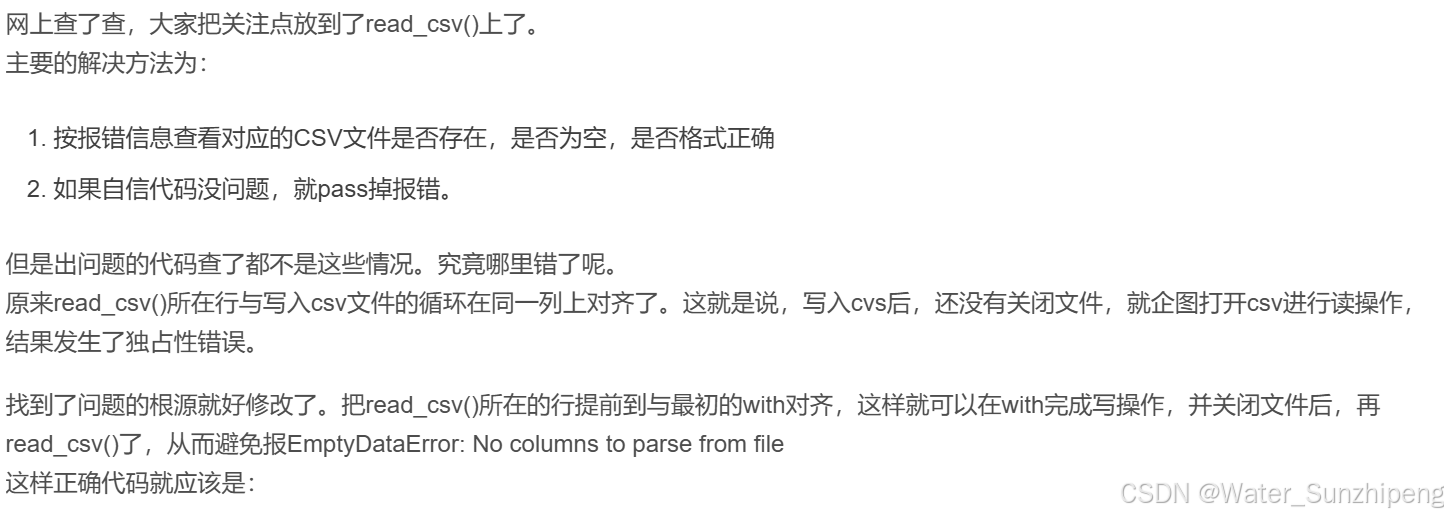
過擬合泛化性弱
欠擬合解決方法:
? ? ? ? 增加輸入特征項
? ? ? ? 增加網絡參數
? ? ? ? 減少正則化參數
過擬合的解決方法:
? ? ? ? 數據清洗
? ? ? ? 增大訓練集
? ? ? ? 采用正則化
? ? ? ? 增大正則化參數
正則化緩解過擬合
正則化在損失函數中引入模型復雜度指標,利用給w增加權重,弱化數據集的噪聲,loss = loss(y與y_) + REGULARIZER*loss(w)
模型中所有參數的損失函數,如交叉上海,均方誤差
利用超參數REGULARIZER給出參數w在總loss中的比例,即正則化權重, w是需要正則化的參數

正則化的選擇
L1正則化大概率會使很多參數變為0,因此該方法可通過系數參數,減少參數的數量,降低復雜度
L2正則化會使參數很接近0但不為0,因此該方法可通過減少參數值的大小降低復雜度?
with tf.GradientTape() as tape:h1 = tf.matul(x_train, w1) + b1h1 = tf.nn.relu(h1)y = tf.matmul(h1, w2) + b2loss_mse = tf.reduce_mean(tf.square(y_train - y))loss_ragularization = []loss_regularization.append(tf.nn.l2_loss(w1))loss_regularization.append(tf.nn.l2_loss(w2))loss_regularization = tf.reduce_sum(loss_regularization)loss = loss_mse + 0.03 * loss_regularization
variables = [w1, b1, w2, b2】
grads = tape.gradient(loss, variables)生成網格覆蓋這些點,會對每個坐標生成一個預測值,輸出預測值為0.5的連成線,這個線就是紅點和藍點的分界線。

# 導入所需模塊
import tensorflow as tf
from matplotlib import pyplot as plt
import numpy as np
import pandas as pd# 讀入數據/標簽 生成x_train y_train
df = pd.read_csv('dot.csv')
x_data = np.array(df[['x1', 'x2']])
y_data = np.array(df['y_c'])x_train = x_data
y_train = y_data.reshape(-1, 1)Y_c = [['red' if y else 'blue'] for y in y_train]# 轉換x的數據類型,否則后面矩陣相乘時會因數據類型問題報錯
x_train = tf.cast(x_train, tf.float32)
y_train = tf.cast(y_train, tf.float32)# from_tensor_slices函數切分傳入的張量的第一個維度,生成相應的數據集,使輸入特征和標簽值一一對應
train_db = tf.data.Dataset.from_tensor_slices((x_train, y_train)).batch(32)# 生成神經網絡的參數,輸入層為4個神經元,隱藏層為32個神經元,2層隱藏層,輸出層為3個神經元
# 用tf.Variable()保證參數可訓練
w1 = tf.Variable(tf.random.normal([2, 11]), dtype=tf.float32)
b1 = tf.Variable(tf.constant(0.01, shape=[11]))w2 = tf.Variable(tf.random.normal([11, 1]), dtype=tf.float32)
b2 = tf.Variable(tf.constant(0.01, shape=[1]))lr = 0.005 # 學習率為
epoch = 800 # 循環輪數# 訓練部分
for epoch in range(epoch):for step, (x_train, y_train) in enumerate(train_db):with tf.GradientTape() as tape: # 記錄梯度信息h1 = tf.matmul(x_train, w1) + b1 # 記錄神經網絡乘加運算h1 = tf.nn.relu(h1)y = tf.matmul(h1, w2) + b2# 采用均方誤差損失函數mse = mean(sum(y-out)^2)loss_mse = tf.reduce_mean(tf.square(y_train - y))# 添加l2正則化loss_regularization = []# tf.nn.l2_loss(w)=sum(w ** 2) / 2loss_regularization.append(tf.nn.l2_loss(w1))loss_regularization.append(tf.nn.l2_loss(w2))# 求和# 例:x=tf.constant(([1,1,1],[1,1,1]))# tf.reduce_sum(x)# >>>6loss_regularization = tf.reduce_sum(loss_regularization)loss = loss_mse + 0.03 * loss_regularization # REGULARIZER = 0.03# 計算loss對各個參數的梯度variables = [w1, b1, w2, b2]grads = tape.gradient(loss, variables)# 實現梯度更新# w1 = w1 - lr * w1_gradw1.assign_sub(lr * grads[0])b1.assign_sub(lr * grads[1])w2.assign_sub(lr * grads[2])b2.assign_sub(lr * grads[3])# 每200個epoch,打印loss信息if epoch % 20 == 0:print('epoch:', epoch, 'loss:', float(loss))# 預測部分
print("*******predict*******")
# xx在-3到3之間以步長為0.01,yy在-3到3之間以步長0.01,生成間隔數值點
xx, yy = np.mgrid[-3:3:.1, -3:3:.1]
# 將xx, yy拉直,并合并配對為二維張量,生成二維坐標點
grid = np.c_[xx.ravel(), yy.ravel()]
grid = tf.cast(grid, tf.float32)
# 將網格坐標點喂入神經網絡,進行預測,probs為輸出
probs = []
for x_predict in grid:# 使用訓練好的參數進行預測h1 = tf.matmul([x_predict], w1) + b1h1 = tf.nn.relu(h1)y = tf.matmul(h1, w2) + b2 # y為預測結果probs.append(y)# 取第0列給x1,取第1列給x2
x1 = x_data[:, 0]
x2 = x_data[:, 1]
# probs的shape調整成xx的樣子
probs = np.array(probs).reshape(xx.shape)
plt.scatter(x1, x2, color=np.squeeze(Y_c))
# 把坐標xx yy和對應的值probs放入contour函數,給probs值為0.5的所有點上色 plt.show()后 顯示的是紅藍點的分界線
plt.contour(xx, yy, probs, levels=[.5])
plt.show()# 讀入紅藍點,畫出分割線,包含正則化
# 不清楚的數據,建議print出來查看
 存在過擬合現象,輪廓不夠平滑, 使用l2正則化緩解過擬合
存在過擬合現象,輪廓不夠平滑, 使用l2正則化緩解過擬合
# 導入所需模塊
import tensorflow as tf
from matplotlib import pyplot as plt
import numpy as np
import pandas as pd# 讀入數據/標簽 生成x_train y_train
df = pd.read_csv('dot.csv')
x_data = np.array(df[['x1', 'x2']])
y_data = np.array(df['y_c'])x_train = x_data
y_train = y_data.reshape(-1, 1)Y_c = [['red' if y else 'blue'] for y in y_train]# 轉換x的數據類型,否則后面矩陣相乘時會因數據類型問題報錯
x_train = tf.cast(x_train, tf.float32)
y_train = tf.cast(y_train, tf.float32)# from_tensor_slices函數切分傳入的張量的第一個維度,生成相應的數據集,使輸入特征和標簽值一一對應
train_db = tf.data.Dataset.from_tensor_slices((x_train, y_train)).batch(32)# 生成神經網絡的參數,輸入層為4個神經元,隱藏層為32個神經元,2層隱藏層,輸出層為3個神經元
# 用tf.Variable()保證參數可訓練
w1 = tf.Variable(tf.random.normal([2, 11]), dtype=tf.float32)
b1 = tf.Variable(tf.constant(0.01, shape=[11]))w2 = tf.Variable(tf.random.normal([11, 1]), dtype=tf.float32)
b2 = tf.Variable(tf.constant(0.01, shape=[1]))lr = 0.005 # 學習率為
epoch = 800 # 循環輪數# 訓練部分
for epoch in range(epoch):for step, (x_train, y_train) in enumerate(train_db):with tf.GradientTape() as tape: # 記錄梯度信息h1 = tf.matmul(x_train, w1) + b1 # 記錄神經網絡乘加運算h1 = tf.nn.relu(h1)y = tf.matmul(h1, w2) + b2# 采用均方誤差損失函數mse = mean(sum(y-out)^2)loss_mse = tf.reduce_mean(tf.square(y_train - y))# 添加l2正則化loss_regularization = []# tf.nn.l2_loss(w)=sum(w ** 2) / 2loss_regularization.append(tf.nn.l2_loss(w1))loss_regularization.append(tf.nn.l2_loss(w2))# 求和# 例:x=tf.constant(([1,1,1],[1,1,1]))# tf.reduce_sum(x)# >>>6loss_regularization = tf.reduce_sum(loss_regularization)loss = loss_mse + 0.03 * loss_regularization # REGULARIZER = 0.03# 計算loss對各個參數的梯度variables = [w1, b1, w2, b2]grads = tape.gradient(loss, variables)# 實現梯度更新# w1 = w1 - lr * w1_gradw1.assign_sub(lr * grads[0])b1.assign_sub(lr * grads[1])w2.assign_sub(lr * grads[2])b2.assign_sub(lr * grads[3])# 每200個epoch,打印loss信息if epoch % 20 == 0:print('epoch:', epoch, 'loss:', float(loss))# 預測部分
print("*******predict*******")
# xx在-3到3之間以步長為0.01,yy在-3到3之間以步長0.01,生成間隔數值點
xx, yy = np.mgrid[-3:3:.1, -3:3:.1]
# 將xx, yy拉直,并合并配對為二維張量,生成二維坐標點
grid = np.c_[xx.ravel(), yy.ravel()]
grid = tf.cast(grid, tf.float32)
# 將網格坐標點喂入神經網絡,進行預測,probs為輸出
probs = []
for x_predict in grid:# 使用訓練好的參數進行預測h1 = tf.matmul([x_predict], w1) + b1h1 = tf.nn.relu(h1)y = tf.matmul(h1, w2) + b2 # y為預測結果probs.append(y)# 取第0列給x1,取第1列給x2
x1 = x_data[:, 0]
x2 = x_data[:, 1]
# probs的shape調整成xx的樣子
probs = np.array(probs).reshape(xx.shape)
plt.scatter(x1, x2, color=np.squeeze(Y_c))
# 把坐標xx yy和對應的值probs放入contour函數,給probs值為0.5的所有點上色 plt.show()后 顯示的是紅藍點的分界線
plt.contour(xx, yy, probs, levels=[.5])
plt.show()# 讀入紅藍點,畫出分割線,包含正則化
# 不清楚的數據,建議print出來查看

python EmptyDataError No columns to parse from file sites:stackoverflow.com



)






,收藏~)




)




